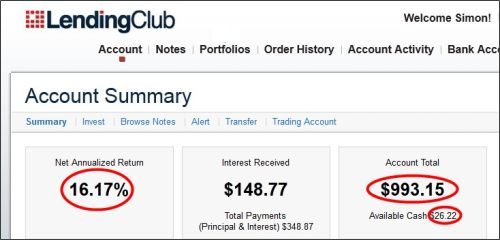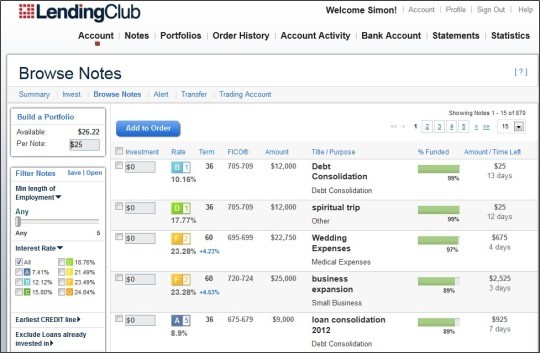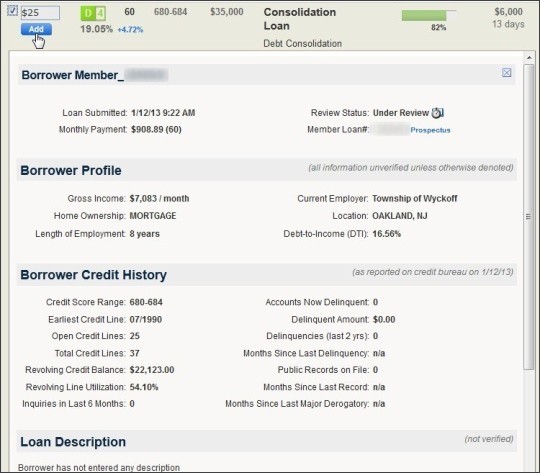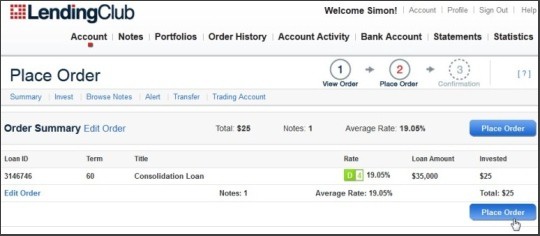Part 1 – An Overview
Part 2 – Lending Step-by-Step
Part 3 – Filtering Loans
Part 4 – Final Pieces
In the first part, we looked at what peer to peer lending broadly meant. Now will be looking more closely at its five-step process. If you are someone still trying to understand it all, this step-by-step outline should be a helpful resource.
Here are the five basic steps of peer to peer lending:
- Log in to your account
- Filter the platform for quality loans
- Invest in loans
- Receive payments
- Reinvest these returns into additional loans
Let’s look at each of these steps using Lending Club’s platform.
1. Log Into Your Account
First, go to the LendingClub.com or Prosper.com website (open an account if you have not done so). Upon logging onto the platform, you will see the home screen of your account. Of course, Prosper and Lending Club have different terminology for this page (and near everything else), but it’s basically the same for both. Lending Club calls this your “Account Summary” page; Prosper calls it your “Account Overview”.
On your account page three important numbers will be listed: (1) your current return on investment (ROI), (2) a dollar amount for the account total you have invested on the platform, and (3) a dollar amount for how much available cash you have to invest. Prosper and Lending Club have slightly different pages, but all of them have these three important numbers. You can see these three numbers circled below.
Probably the most important item on this page is your return on investment, or ROI (for this example, it is 16.17%). This percentage is the rate you are earning per year on your account, like a savings account rate. Platforms call this your Net Annualized Return (NAR) and give a value that is often over inflated. Great tools like NickelSteamroller’s Portfolio Analyzer can give you a better measurement of this number.
2. Filter the Platform for Quality Loans
Once you examine your account, it’s time to begin lending. Click on the link that says “Browse Listings” or “Browse Notes”. The platform will bring up hundreds of available loans for lending. This is where beginners can get overwhelmed because a lot of terminology presented on the Browse Notes page: interest rates, loan titles, percentage bars and different colored boxes.
From the Browse page, you can use a “saved filter” (Lending Club) or “saved search” (Prosper) to filter out the best available loans, often leaving a much smaller list from the original hundreds. The task of filtering available loans is probably the most complicated part of peer to peer lending, and is covered in part 3.
Once your filter has slimmed down the large pool of available loans into a smaller higher-quality list, you can begin the much simpler task of choosing some loans to invest in and weeding out other loans that satisfied your filter criteria but don’t meet your standards. For instance, a typical Lending Club filter I have used required borrowers to have been employed at least four years. Interestingly enough, this filter sometimes gave me a loan that shows a person’s place of employment as N/A (not available), meaning they did not fill out their employer’s name. Basically, the borrower says they have four years of employment, but refuse to say where. I would skip this loan, as plenty of other loans exist that actually do state their employers.
3. Invest In A Loan
Now comes the big moment. If you find a loan that survives your filters and meets your follow-up inspection, you can fund a small portion of the loan, called a note. Instead of finding someone to fund the entire loan, peer to peer lending platforms allow for hundreds of lenders to each buy a note, a small portion of the entire loan. Some loans can be larger than $30,000, and are funded this way by hundreds of lenders. It is suggested you do not invest more than $25 per loan because you want to place your investment pool in as many loans as possible. This is called diversifying. A truly diversified account has at least 200 notes, so if you are investing more than $10,000 then you could invest using $50 notes (and so on).
4. Receive payments
After investing, it may take a month or more before you see any returns. This is because the loan needs more investors to fully fund the loan. The process may also take longer if the loan needs to be reviewed by the platform. If the loan is not funded or fails its review, the money you have invested will be redeposited into your account. If the loan is successfully issued, you begin receiving payments every 30 days. These payments will continue until the loan is paid off. Most loans either carry a 36 month (three year) or 60 month (five year) term, though Prosper.com also issues loans with a 12 month term.
5. Reinvest those returns
Once money from your invested loans starts flowing back into your account, you should reinvest this money into the platform. If you let these funds lie dormant in your account they do not earn interest. It’s important to set up a routine where you log in and reinvest your available funds on some sort of schedule. Those with smaller accounts may only need to log in every month, but those with larger accounts may need to check in more regularly.
Conclusion
At first, peer to peer lending can be somewhat foreign, but with just a little interaction you should find it to be quite simple, beautiful even. The best way to become familiar with anything is real experience. Reading materials on the internet, including this article, are a bad replacement for actually opening an account with Lending Club or Prosper and trying it out for yourself.
With just a little interaction, you may become as enamored as I am by the ease of lending our extra funds to those around the country who need them.
In part three we focus on filters, the backbone of every peer to peer lender’s account.
Questions or comments? If you enjoyed this please Like or Tweet it below.
[image credit: Jarosław Pocztarski ‘Stone Steps‘ CC-BY 2.0]





Leave a question or comment